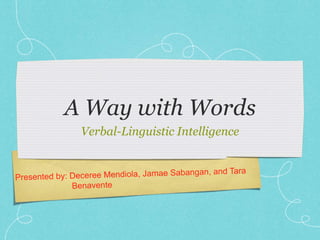
Ch 1 presentation
- 2. Verbal-Linguistic Intelligence Consists of the ability to think in words and to use language to express and appreciate complex meanings High Exhibitors of Linguistic Intelligence: Authors, poets, journalists, speakers, and newscasters
- 3. Characteristics Listens and responds to the sound, rhythm, color, and variety of the spoken word Imitates sounds, language, reading and the writing of others Learns through listening, reading and discussing
- 4. Characteristics Listens effectively, comprehends, paraphrases, interprets, remembers, and analyzes what has been said Reads effectively, comprehends, summarizes, interprets or explains and remembers what has been read; enjoys one or more literary genres Speaks effectively to a variety of audiences Writes effectively
- 5. Outline I. Listening II. Speaking III. Reading IV. Writing
- 6. Listening to Learn 10 Keys to Effective Learning Image source – http://www.4thringroad.com/?p=2922 10 Keys to Effective Learning Weak Listeners Strong Listeners 1. Find areas of interest Tune out “dry” subjects Ask “What interests me?” 2. Judge content, not delivery Tune out if delivery is poor Judge content; skip over delivery errors 3. Be open-minded Tend to enter into argument Withhold judgment until comprehension is complete 4. Listen for big ideas Listen for facts Listen for central themes 5. Take notes appropriately Take intensive notes using only one system Take fewer notes; use different systems, depending on speaker and material
- 7. Listening to Learn 10 Keys to Effective Learning 6. Work at listening Fake attention Work hard; exhibit active body state 7. Resist distractions Are easily distracted Ignore distractions; know how to concentrate 8. Engage intellectually Resist difficult material; seek simple material Use dense material as exercise for the mind 9. Consider Options Agree with information if it supports preconceived ideas Consider diverse points of view before forming opinions 10. Capitalize on the fact that thought is faster than speech Tend to daydream with slow speakers Challenge, anticipate, summarize; weigh the evidence; listen between the lines
- 8. Listening to Stories & Read Aloud • Telling stories and reading aloud can engage interest and facilitate learning in all subject areas History: Read aloud letters or journals of historical figures Science: Introduce how important discoveries were made by people such as Alexander Graham Bell, Thomas Edison, and Marie Curie • Sharing biographical information brings people and their work to life
- 9. Listening to Poetry • Short poems can introduce many curriculum units • Teachers can compile and share poems with each other to complement subject area Image source – http://www.treehugger.com/files/2008/03/book-swap-green-choice.php
- 10. Teachers as Storytellers • Storytelling is a great teaching technique that delights young and old learners alike People of all ages find it easy to remember information when it is encoded in a story All of us are storytellers • Subject Matter Stories • The Cultural Dimensions of Storytelling
- 11. Teachers as Storytellers What is the setting in the story? How do you imagine it to look? Who are the characters? What are the personal qualities of the characters? What human traits appear to be respected in the story? What did you learn about this community? Are there stereotypes that the story reinforces or diminishes about this culture? Questions for Discussion:
- 12. Listening to Lectures • Lectures are an effective means of presenting information to large groups of older students • Students should learn effective ways to listen to them Image source – http://serc.carleton.edu/NAGTWorkshops/assess/lgclass.html
- 13. Suggestions to Sharpen Student’s Listening Abilities • Teachers might present a lecture on an unfamiliar topic. To begin, give the title of the topic and ask students some questions. • Another useful exercise is to ask students to listen to a lecture without taking notes. Follow the lecture by having students list everything they can remember. • Teachers can also provide students with blank listening guides to complete as information is presented. Refer to page 12.
- 14. Speaking What we communicate in speech: • 7% Words • 38%Tone of voice • 55%Gestures ~Albert Mehrabian, Silent Messages Image Source – http://www.yankodesign.com/2008/06/04/1-speak-er/
- 15. Speaking • Teacher modeling is key! • Create the right environment Relaxing & positive atmosphere Thought-provoking & open-ended questions
- 16. Classroom Discussion Five Stages of Discussion 1. Explain purpose & standards 2. Hold discussion 3. Keep track 4. End discussion 5. Debrief discussion Image Source – http://www.flickr.com/photos/jeffwolfsberg/3024614997/I
- 17. Classroom Discussion o Think-Pair-Share o Buzz Group o Fishbowls o “Talking Tokens” o “Talking Circles” o Diverse Contribution Methods:
- 18. *Sparkle!* Rules o A card containing a spelling word will be chosen and be read by the presenter o The group that chose the card must spell the word, one letter per group member o After the last letter of the word has been spelled, the subsequent member must yell “Sparkle!” o If the word is misspelled, the other team gets a chance to spell the word correctly
- 19. Reading Image Source – http://headrush.typepad.com/creating_passionate_users/2007/01/index.html http://s424.photobucket.com/albums/pp328/bettytrue/?action=view¤t=031505_Divinity_Library_57.jpg&newest=1 http://usedbooksblog.com/blog/category/book-statistics/
- 20. The act or art of forming visible letters or characters, specifically handwriting; the act or art of literary composition Reinforced by speaking, listening and reading
- 21. Teachers as Writing Models Demonstrate pleasure in the writing process and efforts to refine skills. Finding support and inspiration in helpful online sources. Thinking out loud Choosing topics Sharing personal writing pieces with students
- 26. Writing Groups
- 27. Nurturing an Appreciation for the Process of Writing
- 29. Conclusion I. Listening II. Speaking III. Reading IV. Writing
- 30. Questions? Image source – http://psicommunications.typepad.com/
- 31. Bibliography Campbell, L., Campbell, B., & Dickinson, D. (2004). Teaching and learning through multiple intelligences (3rd ed.). Boston: Pearson Education, Inc.